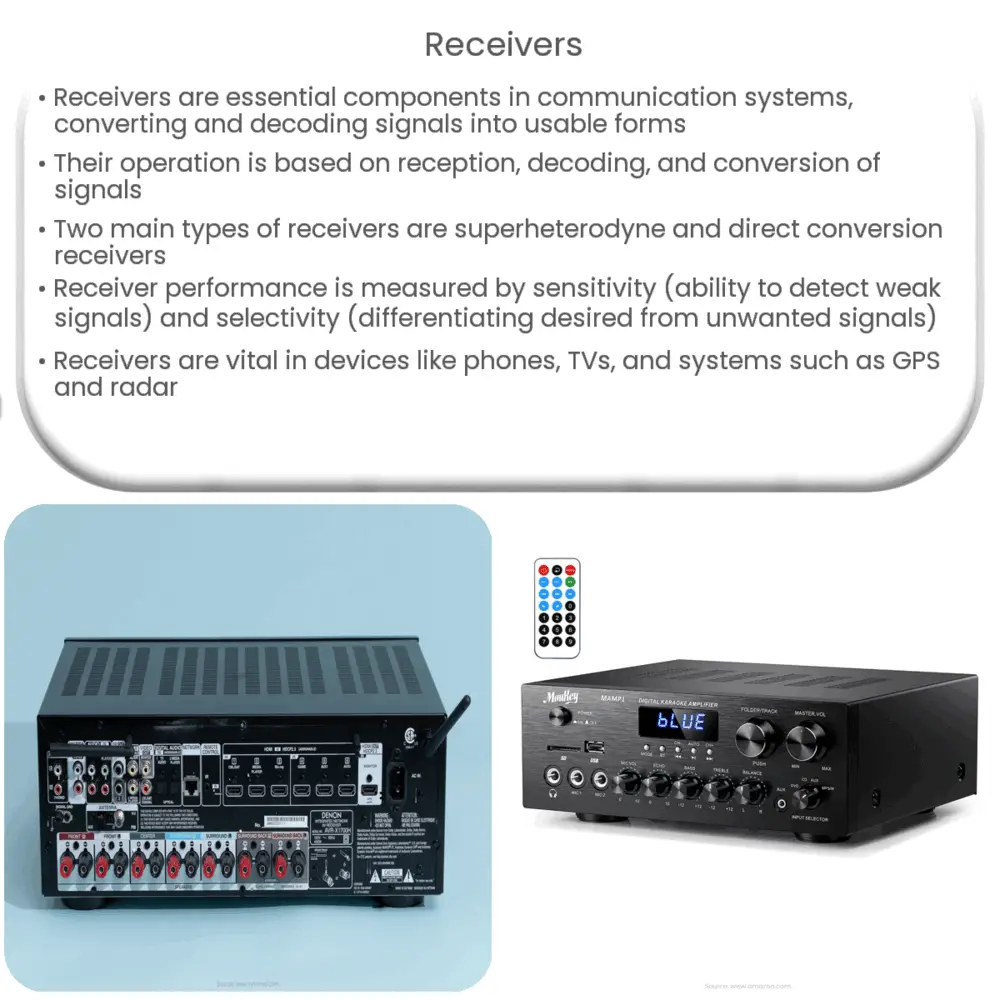Explore the role of receivers in communication systems, from basic principles to types and applications, and their impact on signal quality.

A Comprehensive Look at Receivers
The term ‘receiver’ permeates numerous sectors, from telecommunications to football. However, for the purpose of this article, our focus will rest mainly on the technology and engineering perspective. More specifically, we will explore receivers in radio communication and telecommunication systems.
What is a Receiver?
A receiver is a crucial component in any communication system, whether it’s wired or wireless. It’s an electronic device that collects and decodes signals from various channels to transform them into a usable form. The process can involve converting signals from one energy form to another, for instance, from electrical signals to audio signals.
The Fundamentals of Receivers
The operation of a receiver is premised on three fundamental processes:
- Reception: This is the process where the receiver takes the transmitted signals from the medium or channel.
- Decoding: The receiver then decodes or demodulates the signals to extract the information contained therein.
- Conversion: After decoding, the receiver converts the signals from their initial form to a more understandable or usable form.
Let’s delve into the diverse types of receivers and how they function.
Types of Receivers
Receivers can be broadly categorized based on their method of operation. The two main categories are:
- Superheterodyne receivers
- Direct conversion receivers
A superheterodyne receiver uses frequency mixing or heterodyning to convert the received signal to a fixed intermediate frequency (IF). This receiver type is commonplace in various applications, including television and radio broadcasting systems.
In contrast, a direct conversion receiver (often referred to as a homodyne, synchrodyne, or zero-IF receiver) directly demodulates the incoming radio frequency (RF) signal without first converting it to an intermediate frequency. This simplifies the receiver design but requires more precision in tuning and filtering.
It’s noteworthy to mention that the application of each receiver type largely depends on the system’s requirements and specifications.
Now, let’s move towards a deeper understanding of receivers by exploring the importance of receiver sensitivity and selectivity, as well as their role in a communication system.
Receiver Sensitivity and Selectivity
Receiver sensitivity refers to the minimum signal strength a receiver can detect and successfully demodulate. It’s a crucial parameter as it determines the receiver’s performance under weak signal conditions. Lower the sensitivity level, better is the receiver’s ability to pick up weak signals.
Receiver selectivity, on the other hand, refers to the receiver’s capability to differentiate between the desired signal and unwanted signals (such as noise and signals from other channels). High selectivity is desirable in receivers, as it enhances the quality of the received signal.
Role of Receivers in a Communication System
Receivers play a crucial role in any communication system. They enable the interpretation and utilization of information transmitted over the communication channel. Without a receiver, the transmission process would be meaningless, as there would be no way to decode and understand the transmitted information.
Applications of Receivers
Receivers have wide-ranging applications across multiple domains. In telecommunication, they are used in mobile phones, televisions, and radios to receive and convert transmitted signals. In astronomy, receivers are used in telescopes to detect signals from space. Other areas of application include GPS systems, radar systems, and in wireless computer networks.
Conclusion
In conclusion, receivers form an integral part of any communication system, effectively bridging the gap between information transmission and consumption. They function on the principle of receiving, decoding, and converting signals into a usable form, and their performance is largely gauged on parameters like sensitivity and selectivity. From common household devices like TVs and radios to sophisticated systems like radar and GPS, receivers play a pivotal role, making communication and data exchange possible. As technology continues to evolve, it is clear that the significance and functionality of receivers will continue to be vital in numerous applications.




